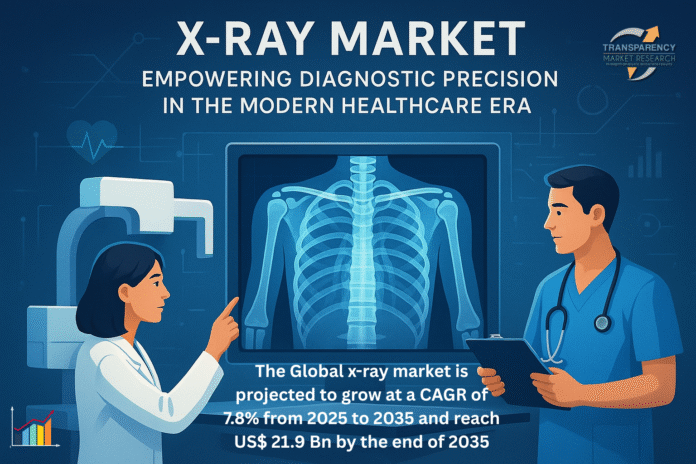Diagnostic imaging is the cornerstone of modern medicine, and among these, X-ray continues to be at the forefront. From routine chest examinations and bone injury studies to advanced digital radiography and mammography, X-ray systems form the first line of diagnosis in global healthcare networks. Moving into the next generation, the X-ray market has entered a time characterized by intelligence, precision, and accessibility.
The X-ray industry today stands at an important juncture where medical science meets digitization. With the adaptation of AI-powered imaging systems, portable diagnostic equipment, and advanced software solutions, X-rays have become faster, safer, and more accurate than ever. In the meantime, with the rise of a number of lifestyle diseases, aging populations across the world, and increasing demand for early diagnosis, the outlook for the X-ray market is very promising.
Strong Market Outlook
The X-ray market has recorded steady growth, supported by increasing patient volumes, advances in imaging technologies, and the expansion of healthcare infrastructure in emerging economies. As awareness of preventive healthcare among people grows, so does the demand for precise diagnostic modalities.
The global X-ray industry reached a valuation of US$ 9.6 Billion in 2024. Rising focus on digital radiography, auto-reporting, and minimally invasive diagnosis is strengthening market expansion. The industry will continue to experience rapid growth and technological advancement as innovation in the field intensifies. According to market forecasts, the X-ray market is set to exhibit a CAGR of 7.8% from 2025 to 2035 and attain US$ 21.9 Billion by the end of 2035.
Such advancement reflects a major transformation in healthcare priorities where speed, clarity, and safety of the patient stand at the forefront.
Key Growth Drivers
Digital Transformation in Imaging
Radiology departments have been revolutionized by the shift from film-based systems to digital radiography. Digital images offer better resolution, faster processing, low storage requirement, and quick sharing. Lower radiation exposure is also another prime cause for higher adaptation in hospitals and diagnostic centers.
Increased prevalence of various chronic diseases
The rise in the incidence of various orthopaedic disorders, cardiovascular diseases, lung infections, and cancers continues to raise the demand for X-ray systems. From suspected bone fractures, pneumonia diagnosis, to cancer screening, X-ray imaging is usually the first step in diagnosis.
Surge in Portable & Mobile X-ray Systems
The health care system is no longer bound to traditional settings. Portable X-ray has brought a whole new dimension to emergency and critical care departments of hospitals, rural health care units, military operations, and home-based medical assistance. The ability to conduct real-time imaging at the point of care has been highly useful during global health crises such as the COVID-19 pandemic.
AI-Integrated Imaging & Smart Diagnostics
Artificial intelligence is creating a revolution in radiology by helping the clinicians interpret faster and with reduced errors. AI tools now help detect fractures, lung abnormalities, tumors, and infections with enhanced accuracy. Automated reporting and machine learning algorithms are improving workflow efficiency and patient management.
Applications Beyond Hospitals
While the core application area is indeed healthcare, X-ray technology goes way beyond hospitals and clinics: it forms the basis of industrial inspection for precision manufacturing, transport security screening, aerospace, and veterinary medicine. This multi-sector adoption enhances market stability and widens its future growth potential.
Competitive Landscape & Industry Advancements
Competition in the X-ray market continues to remain aggressive, with leading firms involved in innovation, product upgrades, and geographical expansion. Large companies are investing heavily in advanced image sensors, digital detectors, automated post-processing software, and dose-reduction technologies to help improve their diagnostic performance and patient care.
Therefore, companies, whether industry giants or emerging players, are focusing on innovation, strategic partnerships, and advancements in AI-enabled imaging to establish themselves in the market. Some of the key players in the X-ray industry include Acteon, Agfa-Gevaert Group, Allengers Medical System Limited, SureScan Corporation, Carestream Health, Canon Medical Systems Corporation, Fujifilm Holdings Corporation, Hologic Inc., Koninklijke Philips N.V., Mindray Medical International Limited, New Medical Imaging, Shimadzu Corporation, Samsung Electronics Co., Ltd., GE Healthcare, and other innovators striving toward global imaging excellence.
They remain focused on enhancing imaging clarity, improving clinical efficiency, and building up product portfolios to meet changing healthcare needs.
Future Outlook: Intelligent Imaging & Patient-Centric Healthcare
Digital intelligence, interoperability, and portable healthcare technologies will define the future of the X-ray market. Coming years are likely to witness:
- AI-powered diagnostic workflows and automated image interpretation
- Lightweight handheld X-ray systems for mobility and remote care
- Ultra-low radiation imaging systems for better patient protection
- Cloud-based imaging platforms for real-time collaboration
- Advanced contrast imaging technologies that provide detailed visualizations of organs
The equipment for X-ray imaging will be even more sophisticated, connected, and patient-centric as healthcare systems increasingly move to early diagnosis and real-time monitoring.
Conclusion
The future of X-ray will be revolutionary. Digital innovation, AI integration, portable imaging breakthroughs, and an acutely sharp focus on patient safety reshape the way diagnostics are delivered. From high-precision imaging to other valuable uses expected to grow globally, X-ray technology will be a cornerstone for medical diagnostics, industrial testing, and public safety.
This represents a market not only growing in size but also evolving in intelligence—creating a smarter, safer, and more connected diagnostic ecosystem for the world.
